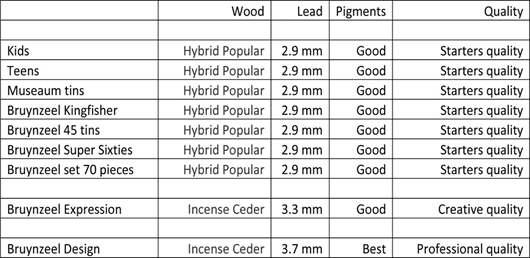Bruynzeel Pencils
All of our pencils are double-glued: the core of the pencil cannot break, even if you drop it. If the tip breaks off after sharpening, it could be due to the pencil sharpener you are using. The importance of using the right pencil sharpener is often underestimated.
There are two different types of pencil sharpeners: one for graphite pencils and one for coloured pencils. The angle at which a graphite pencil is sharpened is different to that of a coloured pencil. This is because a graphite pencil is harder and you can therefore work with a longer tip.
If you sharpen a coloured pencil with a graphite pencil sharpener, the tip will be too long and will break when you apply pressure to it. We therefore recommend that you sharpen coloured pencils with a coloured pencil sharpener.
All of our pencils are wax based, which includes pencils for the very youngest users as well as our professional quality pencils. Wax based pencils glide over the paper slightly more easily than oil based pencils. Wax based pencils also produce a shiny layer on the areas that are coloured in; this effect is less pronounced with oil based pencils. Wax, however, can build up (depending on how much pressure you put on the pencils and how opaque you make the layers), so it is possible that after a number of layers less colour will be transferred.
As standard, around 7-10 layers of varnish are applied to pencils. This depends on the colour used. Lighter colours normally require 9-10 layers of varnish, while darker colours normally require only 7-8 layers.
If a product is gluten free, it is stated in the information on the back. Our products are also listed on the Celiac Disease Foundation website.

Pencils consist of a clay and graphite core in a wooden casing. They therefore no longer contain any lead, as they did in the past. At that time, lead pencils were cheaper than the silver pencils people used to draw or write. The mixture of clay and graphite in the pencil is baked in an oven. The ratio of clay to graphite determines the hardness: the more clay, the harder the pencil. Hard pencils have the letter H and, depending on the hardness, a number running from H (or 1H), 2H, 3H up to and including 9H,; the hardest pencil.
For designers, architects and technical draftsmen, these pencils are suitable for drawing perspective lines, for example, or making precise construction drawings. However, you can also draw expressively with hard pencils. You do this by cross-hatching, creating darker and lighter areas.
Soft pencils have the letter B and are more versatile in applying texture and tone than hard pencils. They range from B (or 1B), 2B, 3B to 9B;, the softest pencil. HB is a mixture of hard and soft and is often used in schools.
For artists, the soft pencils are excellent for adding depth with texture, tone, shading or just a simple line. The very soft pencils can be used for larger areas.
Yes, we have created two great videos about the history and the production process of pencils. Take a look: video about the production and video about the history
The importance of using the right pencil sharpener is often underestimated.
There are two different types of pencil sharpeners: one for graphite pencils and one for coloured pencils. The angle at which a graphite pencil is sharpened is different to that of a coloured pencil. This is because a graphite pencil is harder and you can therefore work with a longer tip.
If you sharpen a coloured pencil with a graphite pencil sharpener, the tip will be too long and will break when you apply pressure to it. We therefore recommend that you sharpen coloured pencils with a coloured pencil sharpener.
If you sharpen a coloured pencil with a graphite pencil sharpener, the tip will be too long and will break when you apply pressure to it. We therefore recommend that you sharpen coloured pencils with a coloured pencil sharpener. (see YouTube video).
Yes, we have carpenter's pencils in lengths of 17.5 cm and 24 cm. In the 17.5 cm length, we offer white, ochre yellow and red carpenter's pencils.
In the 24 cm length, we offer white, orange and red carpenter's pencils. All carpenter's pencils have 3H hardness.
In the 17.5 cm length we offer white, ochre yellow and red carpenter's pencils. In the 24 cm length we offer white, orange and red carpenter's pencils.
Of course, just like other pencils, carpenter's pencils can also have text and/or logo printed on them, for example. Please contact us for more information.
These are actually our Mega coloured pencils in the colour vermilion (the same shade of red as in the Dutch flag). Because the Mega pencils are used in municipal, provincial and national parliamentary elections to mark ballots, they are also known as voting pencils.
Of course. Just like other pencils, voting pencils can also have text and/or logo printed on them, for example.
We use pad printing for our voting pencils. A pad stamp is cut out for printing, dipped in ink and attached to a machine. The pencil is then placed in exactly the right position under the pad stamp. The ink from the stamp is then imprinted on the pencil. That is how we get a printed pencil!
We apply a maximum size of 120 mm wide and 8 mm high.
Please contact us for more information.
A tortillon is made of very tightly rolled paper and is used, among other things, to soften graphite, pastel pencil and charcoal lines and to apply shading.
You can sharpen the tip of the tortillon using a piece of fine sandpaper.